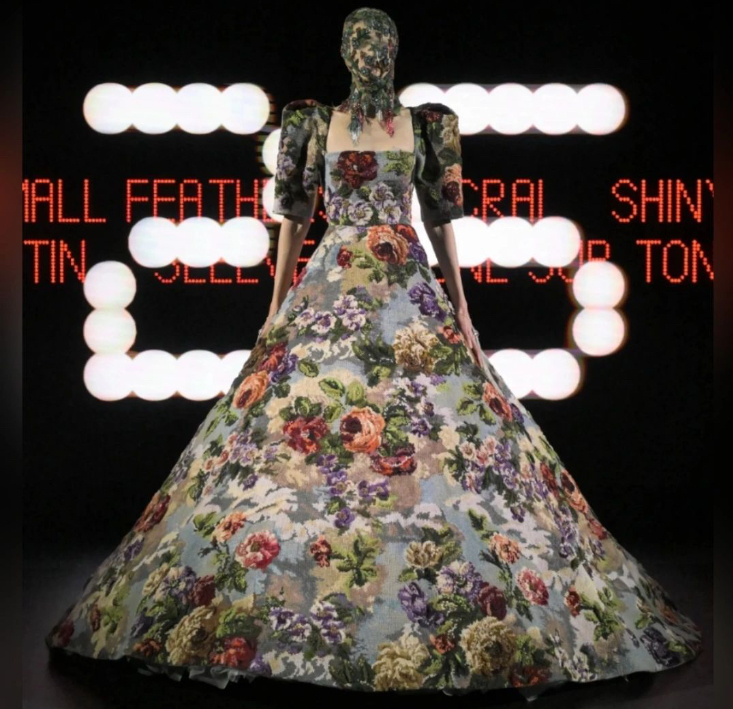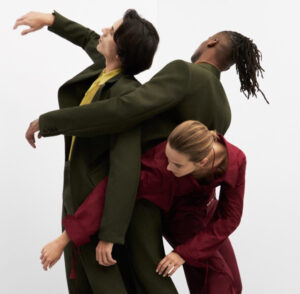

As the last flickers of strobe lights faded and the models disappeared behind the grand proscenium, a collective gasp still echoed through the venue. Alessandro Michele’s first haute couture collection for Valentino had just unfolded in an atmosphere teetering between the baroque and the surreal. Attendees—fashion editors, industry elites, and couture devotees—exited in something close to a trance, some trembling from the sheer sensory overload of it all.
Michele’s entrance into the house of Valentino was never going to be subtle. The former Gucci creative director, known for his maximalist, referential, and almost esoteric approach to fashion, has a singular way of storytelling. His arrival signaled an immediate shift in the house’s identity, yet it was one that, at its core, honored Valentino Garavani’s legacy of beauty, elegance, and dramatic opulence.
This was not a traditional couture show. It was a cinematic psychodrama, an immersive experience that swept its audience into a fever dream of historical silhouettes, intellectual references, and the sheer technical prowess of Valentino’s Roman ateliers. The “Vertgineux” collection, as Michele titled it—meaning “vertiginous” in French—was not just about clothing. It was an emotional and intellectual exploration of identity, heritage, and the infinite possibilities of couture.
Michele’s Philosophy: A Delirium of Inspirations
If there is one constant in Alessandro Michele’s world, it is his voracious curiosity. His work is not simply about aesthetics but about weaving intricate tapestries of cultural, historical, and philosophical narratives. In his own words, preparing for this collection felt like being caught in a tornado of obsessions—a ceaseless immersion into the Valentino archives, Roman heritage, and broader fashion history.
This was couture as metaphysics, as storytelling through fabric, silhouette, and movement.
A digital red river of text projected onto the backdrop of the show enumerated an exhaustive list of inspirations—each garment a node in a vast web of cultural references. There were nods to Venetian carnivals, medieval ecclesiastical robes, Marie Antoinette’s court gowns, silent film actresses draped in dramatic capes, and even the geometric rigor of Victorian crinolines. There were name drops of poets and philosophers, art movements and historical moments, each informing the shapes, textures, and concepts within the collection.
Michele has always been a designer who delves into the past—not as an archivist, but as an alchemist. The past is not something to be replicated but rather to be distilled and transformed. His Valentino debut felt like a historical fever dream, a collection so deeply rooted in past traditions yet wholly unfamiliar in its execution.
The Valentino Archive: A Dialogue with History
Any designer stepping into a house with as much heritage as Valentino must contend with the question of legacy. Michele approached this challenge not as an outsider imposing his vision, but as an interpreter translating Garavani’s original philosophy into a contemporary language.
“It is not a brand, it is a house,” Michele declared. The difference is significant. A house carries history, tradition, and a distinct cultural identity. A brand, on the other hand, is malleable to market trends and reinvention. Michele’s respect for Valentino’s haute couture maison was evident in his meticulous engagement with its archives.
Garavani, the maestro of eleganza, was renowned for his love of grandeur—sweeping ball gowns, regal capes, and sumptuous fabrics. But there was also a purity to his designs, a balance between decadence and discipline. Michele retained this duality, infusing it with his own penchant for theatricality and eccentricity.
Each piece in Vertgineux was a reinterpretation, not a reproduction. The opulence of Valentino’s classic haute couture codes remained, but they were magnified and distorted, pushed into a dreamlike realm. Crinolines were exaggerated to surreal proportions, capes seemed to float with an almost spectral lightness, and embroidery glistened under the stage lights like relics from an alternate history.
The Show: A Performance of Light and Shadow
What set this show apart was its dramatic staging. The models did not simply walk down a conventional runway; they ran across a darkened stage, caught in bursts of strobe light.
This simple yet radical departure transformed the collection into a moving spectacle, a living painting where fabric and form were frozen in flickering tableaus. Every stride, every swirl of a cape, every flicker of an embroidered hem was accentuated, caught in a cinematic slow-motion effect. It was reminiscent of old silent films, of theatrical performances where movement itself was an art form.
This decision underscored Michele’s belief that fashion should be experienced as emotion, not just viewed as product. Each piece was not merely worn; it was performed. The models became figures in a gothic opera, their garments imbued with narrative weight.
This element of movement and shadow also added an air of mystery. Unlike traditional couture presentations, where garments are scrutinized under bright white lights, Michele’s show was deliberately enigmatic. The audience was forced to engage with the spectacle on a visceral level, feeling its impact rather than analyzing its details in real-time.
The Craftsmanship: When Technique Meets Emotion
At the heart of haute couture is craftsmanship. Every stitch, every bead, every layer of tulle in a couture piece is a testament to hours of meticulous labor by the finest artisans in the world.
Valentino’s Roman ateliers are among the most revered in couture history, and Michele utilized their full potential. Despite the theatrical presentation, the technical precision of the garments was undeniable.
The collection was a textural symphony:
•Lustrous silks draped like liquid across the body.
•Velvet and brocade evoked the richness of Renaissance paintings.
•Tulle and organza floated like ghosts from an 18th-century ball.
•Embroidery—both opulent and delicate—glimmered with hidden narratives.
There was an obsessive attention to historical construction techniques—from Georgian panniers to Victorian bustles—reimagined with a modern sensibility. Yet, nothing felt weighed down by the past. Michele’s genius lay in his ability to infuse history with lightness, movement, and relevance.
What This Means for Valentino’s Future
Michele’s Valentino debut is undoubtedly one of the most polarizing couture moments in recent history. For those who admired Pierpaolo Piccioli’s Valentino, with its minimalist grandeur and sweeping monochromatic elegance, Michele’s maximalism may feel overwhelming. But for those who believe couture should be an unrestrained artistic expression, this show marks a new golden era for the house.
His approach is unapologetically intellectual, drawing from sources far beyond fashion. There is an academic rigor to his references, but also a deeply personal, almost chaotic beauty to his execution. He is a romanticist in an era of pragmatism, a designer who dares to push couture into the realm of poetry and performance.
Valentino, under Michele, is not just about dressing women in beautiful clothes. It is about creating entire worlds, evoking emotion, and challenging perceptions. This show was a statement: couture is not a museum relic—it is alive, moving, and evolving.
Final Thoughts: A New Couture Mythology
Alessandro Michele’s Valentino haute couture debut was more than just a fashion show; it was an act of storytelling, a grand opera of historical echoes and modern dreams. It was overwhelming, disorienting, and breathtaking—a show that left the audience trembling, unable to fully process what they had just witnessed.
In an industry that often prioritizes commercial viability, Michele has chosen to remind us that fashion, at its highest level, should transcend the material. It should be an experience. A mythology. A dream.
And with this debut, Michele has set the stage for a Valentino era that is nothing short of vertiginous—dizzying, exhilarating, and impossible to forget.
No comments yet.









